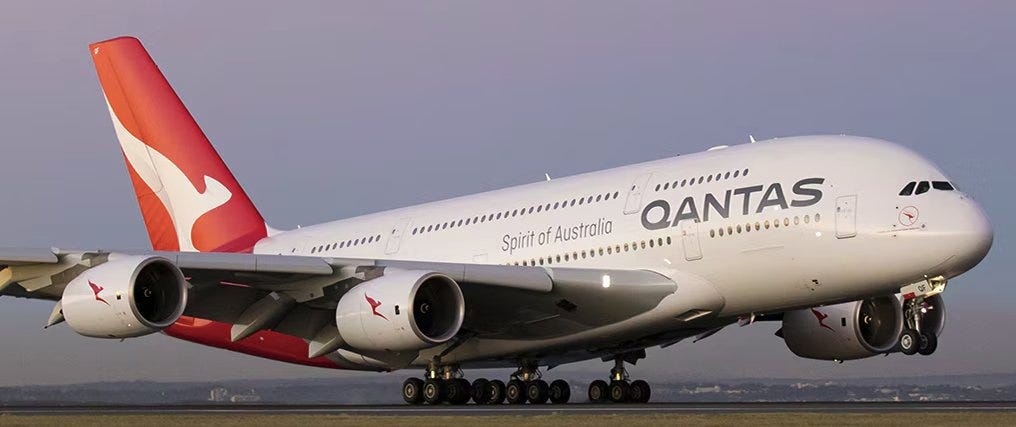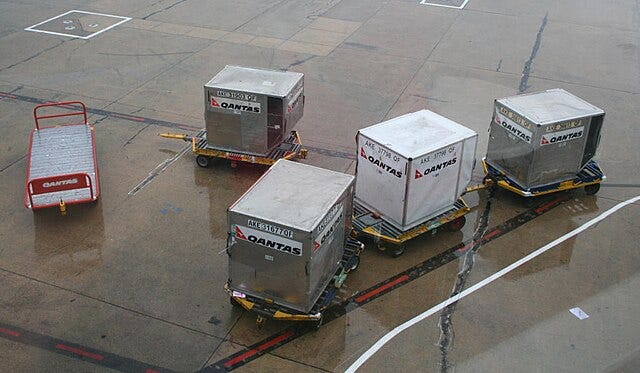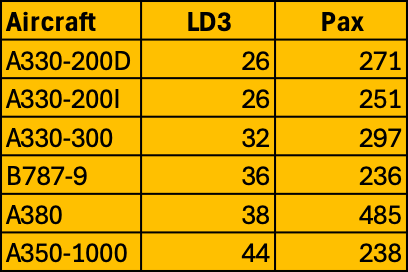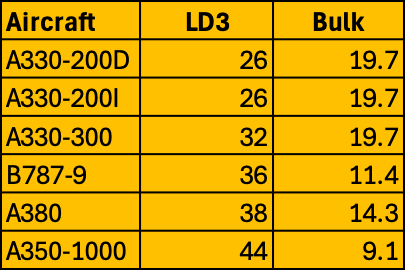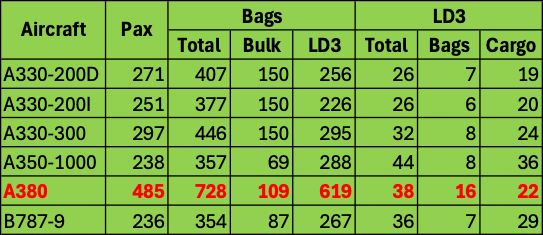Technical Thread #3: The A380s "cargo weakness"
We’re introducing a new feature to Analytic Flying called “Technical Threads” which analyses niche technical topics in a much shorter and to the point format. Originally these began as threads on X (formerly Twitter) and were responding to discussions we’d been engaged in on that platform. But we thought we’d reshare the threads on our website to include it in out archive but also to share with readers who don’t use that platform.
Note: this is the first we’re sharing here but not the first we’ve put together on X. We’re sharing it here as #3, and will share the previous two in the coming week.
We’ve spoken several times about the A380’s “cargo weakness”, arguing it isn’t well-suited to Qantas’s cargo-heavy Asian routes. While this isn’t the only reason they're not often scheduled on Asian routes, we thought we’d put together a thread explain it in detail:
This isn’t a critique of the A380. It's a superb aircraft but its primarily a people carrier; its cargo weakness isn't a design flaw but rather a feature. Flaw implies airlines were surprised by this (they weren’t), but it is part of the reason why some carriers avoided it!
On passenger aircraft, cargo is carried in the belly in standardised containers or pallets. Nearly all contemporary widebodies use the LD3 sized container which carries a maximum of 1.5t or 4.4m3 of cargo (whichever is reached first; most often volume is maxed before weight).
In addition to cargo, LD3s also carry checked luggage! The capacity of each LD3 varies depending on the size & density of the bags, but a good rule-of-thumb is each LD3 fits 40-45 bags (when carrying bags they’ll max out on volume before weight).
This generates a trade-off: more bags → means more LD3s needed → means less space for cargo, and vice versa! And this is where the A380s cargo weakness is exposed!
With two full decks of pax it still only has one deck for bags & cargo! This directly affects the number of positions for LD3 containers: The A380 has space for 38x LD3s. By comparison, this is only slightly more than the B787-9 despite carrying double the passengers!
Making matters worse is that the A380 isn't that long! Well, it's not longer than contemporary widebodies! At 72.7m, she’s shorter than the A350-1000 (73.8m) and B777-9 (76.7m).
But it's a touch more complicated. Not all bags go in LD3s! All widebodies have bulk space in the rear which fits some bags. This varies by type, e.g. the A330s has an unexpectedly large bulk space (19.7 m3). We need to factor this in!
So how many LD3s does each aircraft require for bags & how many remaining for cargo? Estimated this for QF fleet, assuming 1.5 bags/pax & 40 bags/LD3. We factored in bulk space using same volumetric ratio with a 20% haircut due to weight limits & loading constraints.
What’s immediately noticeable is that the A380 requires a lot of LD3s for bags, limiting the remainder available for cargo! Meanwhile, the other types utilise a much lower ratio of their LD3 capacity for bags!
Comparatively, the A380 will need 16 LD3s for bags, leaving 22 for cargo. Meanwhile, the internationally configured A330-200s will need only 6 LDs for bags, and 20 for cargo. The A330-300 is a beast, needing only 8 for bags, leaving 24 for cargo.
You might argue that the A380 is just fine; with 22 LD3s available for cargo this is still more than the 20 on the A330-200 & not that much less than A330-300s. This is correct in absolute terms, but consider the impact on the route network.
QF operate 2x daily Melbourne-Singapore flights with A330-200s (occasionally -300s). Replacing 2x daily A330 with 1x daily A380 will have a similar pax capacity (502 vs 485) but dramatically 45% lower cargo capacity (40 vs 22 LD3s).
Similarly, QF operates 4x daily Australia-Tokyo flights with A330-300s (1188 pax capacity). Replacing this with 2x daily A380 plus 1x daily A330-300 will carry 1267 pax, but reduce the number of LD3s by 52% (from 96 to 46).
Clearly, the A380s cargo limitations are highlighted when looking at the impact of replacing A330s with similar A380 pax capacity. And even then, the A330 isn't the best cargo carrying aircraft in the fleet! The B787-9 & forthcoming A350s are even better!
Some caveats:
It’s affected by cabin density; if QF cram in more seats on any aircraft it worsens its cargo capability as more space will be required for bags. Partly explains B787-9 & A350 given their low density cabins, but doesn't account for the A380's weakness!
Only considers volumetric space! This is because volume is the binding constraint on LD3s; they'll very rarely hit max weight the container can carry. Also, most SE Asian routes unlikely to hit payload limits of the aircraft, or at least regularly.
Following up on our thread, we wanted to throw in some empirical data to show it in action: Qantas have a route where A380 consistently operates alongside B787-9. Luckily, data allows us to compare cargo loads on this route by aircraft type!
Melbourne to Los Angeles is the route! It operates daily, however 2x weekly with A380, 5x weekly with B787-9 (QF 93/94). What’s cool is that we can look at the average cargo carried (by weight) per month broken down by both types!
Eastbound leg (i.e. MEL to LAX) is the best to look at since neither aircraft type is going to have payload limits on its cargo. Westbound leg (LAX to MEL) is more complicated since both types are likely to run into payload limits on its cargo from time to time.
So, how does it look? In 2024, A380 flights carried an average of 7.9t of cargo from MEL to LAX; B789 flights carried an average of 10.1t each! On average, B789 carried more cargo than the A380 in each month; as much as 4.3t more (in Feb 2024)!
The same held true on westbound legs, despite the payload limits.
This reinforces conclusion from earlier thread that the A380's volumetric constraints on cargo mean (on a like-for-like basis) it'll carry less cargo than other aircraft in Qantas's fleet.
Furthermore, it reinforces that there's a trade-off & opportunity cost to scheduling it on cargo heavy routes! That doesn't mean it's a poor aircraft as it can carry a lot more passengers than other aircraft, making it very useful on slot or frequency constrained routes!



